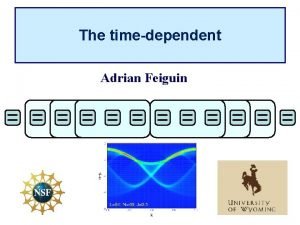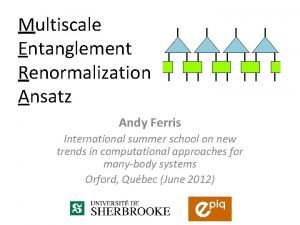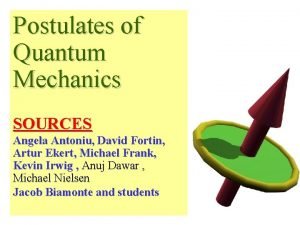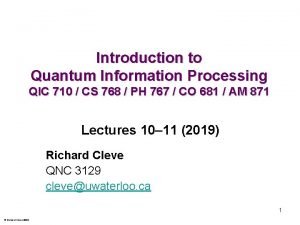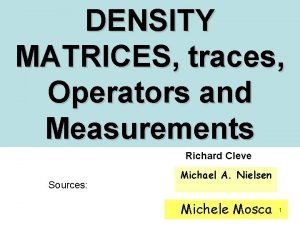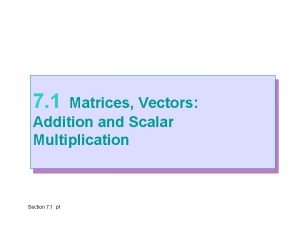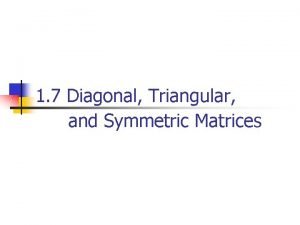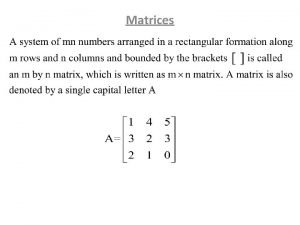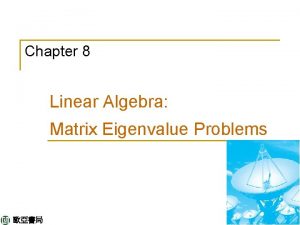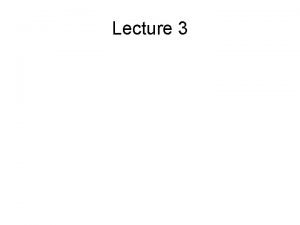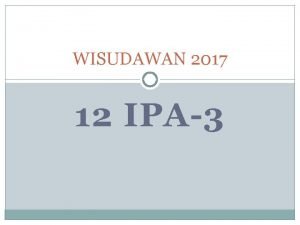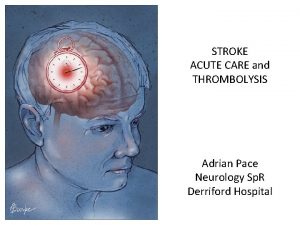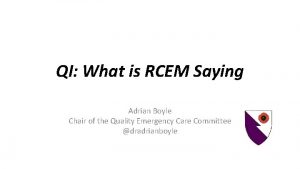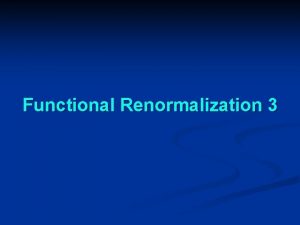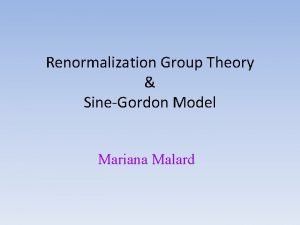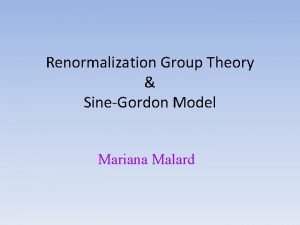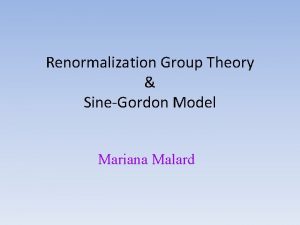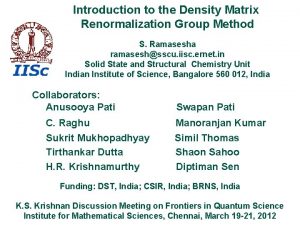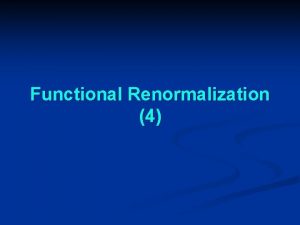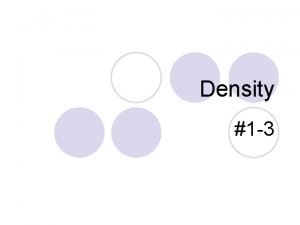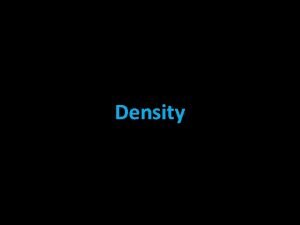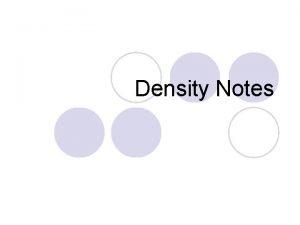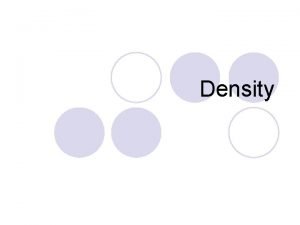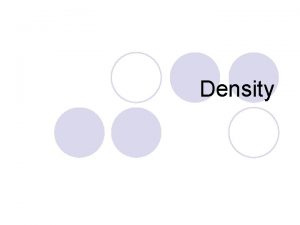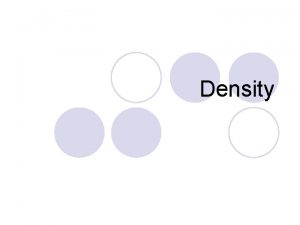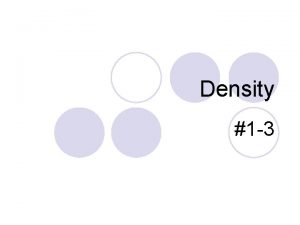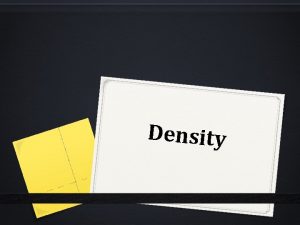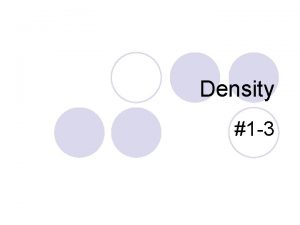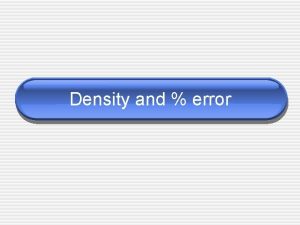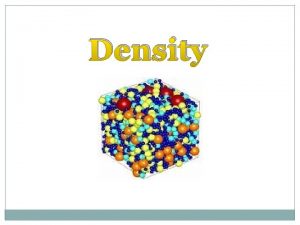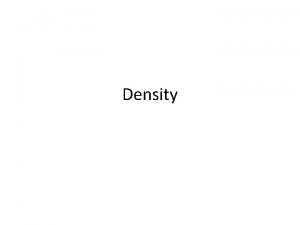The density matrix renormalization group Adrian Feiguin Some











































































- Slides: 75

The density matrix renormalization group Adrian Feiguin



Some literature -S. R. White: . Density matrix formulation for quantum renormalization groups, Phys. Rev. Lett. 69, 2863 (1992). . Density-matrix algorithms for quantum renormalization groups, Phys. Rev. B 48, 10345 (1993). -U. Schollwöck. The density-matrix renormalization group, Rev. Mod. Phys. 77, 259 (2005). -Karen Hallberg. Density Matrix Renormalization: A Review of the Method and its Applications in Theoretical Methods for Strongly Correlated Electrons, CRM Series in Mathematical Physics, David Senechal, Andre-Marie Tremblay and Claude Bourbonnais (eds. ), Springer, New York, 2003. New Trends in Density Matrix Renormalization, Adv. Phys. 55, 477 (2006). -The “DMRG BOOK”: Density-Matrix Renormalization - A New Numerical Method in Physics: Lectures of a Seminar and Workshop held at the Max-Planck-Institut für Physik. . . 18 th, 1998 (Lecture Notes in Physics) by Ingo Peschel, Xiaoqun Wang, Matthias Kaulke and Karen Hallberg -R. Noack and S. Manmana. Diagonalization- and Numerical Renormalization-Group-Based Methods for Interacting Quantum Systems Proceedings of the "IX. Training Course in the Physics of Correlated Electron Systems and High-Tc Superconductors", Vietri sul Mare (Salerno, Italy, October 2004) AIP Conf. Proc. 789, 93 -163 (2005) -A. E. Feiguin. The Density Matrix Renormalization Group and its time-dependent variants Vietri Lecture Notes. http: //physics. uwyo. edu/~adrian/dmrg_lectures. pdf

Brief history and milestones • • • (1992) Steve White introduces the DMRG. (1995 -…) Dynamical DMRG. (Hallberg, Ramasesha et al, Kuhner and White, Jeckelmann) (1995) Nishino introduces the transfer-matrix DMRG (TMRG) for classical systems. (1996 -97) Bursill, Wang and Xiang, Shibata, generalize the TMRG to quantum problems. (1996) Xiang adapts DMRG to momentum space. (2001) Shibata and Yoshioka study FQH systems. (2004) Vidal introduces the TEBD. (time-evolving block decimation) (2005) Verstraete and Cirac introduce an alternative algorithm for MPS’s and explain problem with DMRG and PBC. (2006) White and AEF, and Daley, Schollwoeck et al generalize the ideas within a DMRG framework: adaptive t. DMRG. … the DMRG has been used in a variety of fields and contexts, from classical systems to quantum chemistry, to nuclear physics…

Exact diagonalization “brute force” diagonalization of the Hamiltonian matrix. Schrödinger's Equation: H |x = E |x H : Hamiltonian operator |x : eigenstate E : eigenvalue (ENERGY) … anything you want to know… but… only small systems All we need to do is to pick a basis and write the Hamiltonian matrix in that basis

Exact diagonalization recipe Ingredients ● Lattice (geometry) ● Basis of states (representation) ● Hamiltonian (model/interactions)

Lattices 1 D chain Ladder 2 D

Boundary conditions Open Cylindrical Periodic

What degrees of freedom do we care about? valence band core electrons

Basis of states Occupation number representation (1 orbital per site, spin ½) Empty Spin up Spin down |o |↑ |↓ Double occupied |2 States |x =|x 1 |x 2 |x 3 |x 4. . |x. N Dimension = number of configurations = 4 N N: number of lattice sites

Hamiltonian H=∑i, j. Hij Kinetic energy HK = -t (c†i↑cj↑+c†i↓c j↓+h. c. ) On site interaction(diagonal) HU = U ni↑ni↓ HK |↑o = -t |o↑ HU |2 = U |2 U U→∞

Ising term (diagonal) HIsing = Siz. Sjz HIsing |↑↑ = J/4 |↑↑ Spin flip HJ = J/2 (Si-Sj++Si+Sj-) HIsing |↑↓ = -J/4 |↑↓ HJ |↑↓ = J/2 |↓↑

Hubbard model HHubbard = -t ∑<i, j> (c†i↑cj↑+c†i↓c j↓+h. c. )+U ∑ini↑ni↓ Heisenberg model HHeis = J ∑<i, j> Siz. Sjz+ 1/2 (Si-Sj++Si+Sj-) t-J model Ht-J = -t ∑<i, j>Pt(c†i↑cj↑+c†i↓c j↓+h. c. )P+HHeis

Symmetries SH=HS Particle number conservation => Ntotal Spin conservations => Sztotal Spin reversal => |↑↓ ± |↓↑ Reflections D' = D / 2 Translations D' = D / N | k = (1/M) ∑iaki Ti |f ; aki =exp(ikxi)

Block diagonalization 00 00

ED Example: Heisenberg chain Model Hamiltonian: HHeis = J ∑<i, j> Siz. Sjz+ 1/2 (Si-Sj++Si+Sj-) Geometry: 1 D chain Basis: |↑↓↑↓ ; |↓↑↓↑ ; |↑↑↓↓ ; |↓↑↑↓ ; |↓↓↑↑ ; |↑↓↓↑


Limitations : small lattices • Hubbard model: 20 sites at half filling, 10↑ and 10↓, D=20!(10!10!)x 20!(10!10!) = 2. 4 e+10. After symmetries D'=1. 1 e+8 • t-J model (only |o , |↑ and |↓ states): 32 sites with 4 holes, 14↑ and 14↓, D = 32!/(14!18!)x 18!/(14!4!) = 1. 4 e+12; D'=5. 6 e 9 • Heisenberg model (only |↑ and |↓ states): 36 sites, 18↑ and 18↓, D = 36!/(18!18!)=9075135300; D' =D/(36 x 2 x 2)=1. 5 e 6 states

Exact diag. is limited by system size… How can we overcome this problem? Po’ man’s solution: What about truncating the basis?

“Classical” analogy Image compression algorithms (e. g. Jpeg) We want to achieve “lossless compression” … or at least minimize the loss of information

Idea 1: Truncated diagonalization |gs =∑ ai|xi , ∑ |ai|2 = 1 Usually, only a few important states possess most of the weight Cut here Error = 1 -∑' |ai|2

Truncated diagonalization (continued) 1) We choose a small set of configurations that we know (from results in small systems) are important. E. g. |↑↓↑↓ 2) We apply the Hamiltonian H|x = |y , expanding the basis up to a dimension D. 3) We diagonalize and obtain the ground state: |gs =∑ai|xi 4) We order the weights |ai|2 in descending order 5) We truncate the basis keeping m states with larger weights 6) We go back to 2) until we reach convergence NOTICE: We are still working in the occupation number representation

Idea 2: Change of basis Can we rotate our basis to one where the weights are more concentrated, to minimize the error? Cut here |gs =∑ ai|xi , ∑ |a |2 = 1 i Cut here Error = 1 -∑' |ai|2

What does it mean “to truncate the basis” If we truncate This transformation is no longer unitary, does not preserve norm ->loss of information

The case of spins The two-site basis is given by the states |ss’ ={|↑↑ ; |↑↓ ; |↓↑ ; |↓↓ } We can easily diagonalize the Hamiltonian by rotating with the matrix: That yields the eigenstates:

The case of spins…

Numerical Renormalization Group

Let’s consider the 1 d Heisenberg model For a single site , the operator matrices are: We also need to define the identity on a block of l sites

Building the Hamiltonian a la NRG 2 1 2 3 l-1 l This recursion will generate a 2 lx 2 l Hamiltonian matrix that we can easily diagonalize

Another way to put it… l-1 with l

Adding a single site to the block Before truncating we build the new basis as: And the Hamiltonian for the new block as with

Idea 3: Density Matrix Renormalization Group S. R. White, Phys. Rev. Lett. 69, 2863(1992), Phys. Rev. B 48, 10345 (1993) | = ∑ij ij|i | j Dim=2 L Dimension of the block grows exponentially

Block decimation | = ∑ij ij|i | j Dim=2 N Dim=m constant

The density matrix projection Universe system environment |i | j Solution: The states are the We need to findoptimal the transformation eigenvectors of the reduced density m matrix | = ∑ij ij|i | j ii' = ∑j ij i'j that minimizes the distance | ' = ∑ ja j| | j Tr = 1 2 S = | | ' -| | with the m largest eigenvalues

Understanding the density-matrix projection Universe system environment |i | j Region A The reduced density matrix is defined as: Region B

Properties of the density matrix • • Hermitian -> eigenvalues are real Eigenvalues are non-negative The trace equals to unity-> Tr A=1 Eigenvectors form an orthonormal basis.

The singular value decomposition (SVD) dim. B Consider a matrix (we are choosing dim. B < dim. A for convenience) ij= dim. A We can decompose it into the product of three matrices U, D, V: † =UDV • U is a (dim. Axdim. B) matrix with orthonormal columns-> UU†=1; U=U† • D is a (dim. Bxdim. B) diagonal matrix with non-negative elements l • V is a (dim. Bxdim. B) unitary matrix -> VV†=1 = U x D x V

This is also called the “Schmidt decomposition” of the state

The SVD and the density matrix In general: In the Schmidt basis, the reduced density matrix is • The singular values are the eigenvalues of the reduced d. m. squared i=li 2 • The two reduced density matrices share the spectrum • the singular vectors are the eigenvectors of the density matrix.

Optimizing the wave-function We want to minimize the distance between the two states S=|| ' -| |2 where | is the actual ground state, and | ’ is the variational approximation after rotating to a new basis and truncating | ' = ∑m ja j| | j We reformulate the question as: Given a matrix , what is the optimal matrix ’ with fixed rank r that minimizes the Frobenius distance between the two matrices. It turn out, this is a well known problem, called the “low rank matrix approximation”. If we order the eigenvalues of the density matrix in descending order 1, 2, …, m, …, r we obtain S=|| ' -| |2 = Truncation error!

DMRG: The Algorithm How do we build the reduced basis of states? We grow our basis systematically, adding sites to our system at each step, and using the density matrix projection to truncate

The Algorithm 1) We start from a small superblock with 4 sites/blocks, each with a dimension mi , small enough to be easily diagonalized m 1 1 2 3 4 H 1 2) We diagonalize the system and obtain the ground state |gs =∑ 1234|a 1 |s 2 |s 3 |b 4 3) We calculate the reduced density matrix for blocks 1 -2 and 3 -4. 4) We diagonalize obtaining the eigenvectors and eigenvalues i

m m 2 m'1=m m 2 5) We add a new site to blocks 1 and 4, expanding the basis for each block to m'1 = m m 2 and m'4 = m 3 m 6) We rotate the Hamiltonian and operators to the new basis keeping the m states with larger eigenvalues (notice that we no longer are in the occupation number representation) 7) We repeat starting from 2) replacing H 1 by H'1 and H 4 by H'4 1111 2222 3333 4444

The finite size algorithm We add one site at a time, until we reach the desired system size 1111 2222 3333 4444

The finite size algorithm Wesweepfromleft right to left We to right 1 12 32 1312 23 23 23 32 …Until we converge 423 23 43 4 4

Finite-size DMRG Flow chart

The discarded weight 1 - ∑m =1 measures the accuracy of the truncation to m states

Observations • Sweeping is essential to achieve convergence • Run the finite-size DMRG and extrapolate to thermodynamic limit. • For each system size, extrapolate the results with the number of states m, or fix the truncation error below certain tolerance.

Density Matrix Renormalization Group A variational method without a-priori assumptions about the physics. • Similar capabilities as exact diagonalization. • Can calculate properties of very large systems (1 D and quasi-2 D) with unprecedented accuracy. • Results are variational, but “quasi-exact”: Accuracy is finite, but under control.

Advantages of the DMRG • DMRG is very versatile, and easy to adapt to complex geometries and Hamiltonians. • Can be used to study models of spins, bosons, or fermions. • General and reusable code: A single program can be used to run arbitrary models without changing a single line (e. g. ALPS DMRG) • Symmetries are easy to implement.

Limitations of the DMRG • DMRG is the method of choice in 1 d and quasi-1 d systems, but it is less efficient in higher dimensions. • Problems with (i) critical systems, (ii) long range interactions, and (iii) periodic boundary conditions. • These limitations are due to: – The structure of the variational wave function used by the DMRG (the MPS ansatz). – Entanglement entropy follows area law.

Technicalities… Adding a single site to the block Before truncating we build the new basis as: And the Hamiltonian for the new block as with

. . and for the right block Before truncating we build the new basis as: And the Hamiltonian for the new block as with

Putting everything together to build the Hamiltonian…

Truncation When we add a site to the left block we represent the new basis states as: Similarly for the right block:

Measuring observables Suppose we have a chain and we want to measure a correlation between sites i and j We have two options: 1. Measure the correlation by storing the composite operator in a block 2. Measure when the two operators are on separate blocks We shall go for option (2) for the moment: simpler and more efficient

Operators on separate blocks We only measure when we have the following situation: Then, it is easy to see that: We cannot do this if the two operators are in the same block!!!

Operators on the same block Do never do this: We need to propagate the product operator into the block, the same way as we do for the Hamiltonian

Targeting states in DMRG Our DMRG basis is only guaranteed to represent targeted states, and those only after enough sweeps! If we target the ground state only, we cannot expect to have a good representation of excited states (dynamics). If the error is strictly controlled by the DMRG truncation error, we say that the algorithm is “quasiexact”. Non quasiexact algorithms seem to be the source of almost all DMRG “mistakes”. For instance, the infinite system algorithm applied to finite systems is not quasiexact.

Excited states a) If we use quantum numbers, we can calculate the ground states in different sectors, for instance S=0, and S=1, to obtain the spin gap b) At each step of the DMRG sweep, target the ground state, and the ground state of the modified Hamiltonian: For targeting the two states, we use the density matrix:

2 D Generalization

Why does the DMRG work? ? ? In other words: what makes the density matrix eigenvalues behave so nicely? good! bad!

Entanglement We say that a two quantum systems A and B are “entangled” when we cannot describe the wave function as a product state of a wave function for system A, and a wave function for a system B For instance, let us assume we have two spins, and write a state such as: | =|↑↓ + |↓↑ + |↑↑ + |↓↓ We can readily see that this is equivalent to: | =(|↑ +|↓ )=|↑ x |↓ x -> The two spins are not entangled! The two subsystems carry information independently Instead, this state: | =|↑↓ + |↓↑ is “maximally entangled”. The state of subsystem A has ALL the information about the state of subsystem B

The Schmidt decomposition Universe system environment |i | j We assume the basis for the left subsystem has dimension dim. A, and the right, dim. B. That means that we have dim. A x dim. B coefficients. We go back to the original DMRG premise: Can we simplify this state by changing to a new basis? (what do we mean with “simplifying”, anyway? )

The Schmidt decomposition We have seen that through a SVD decomposition, we can rewire the state as: Where Notice that if the Schmidt rank r=1, then the wave-function reduces to a product state, and we have “disentangled” the two subsystems. After the Schmidt decomposition, the reduced density matrices for the two subsystems read:

The Schmidt decomposition, entanglement and DMRG It is clear that the efficiency of DMRG will be determined by the spectrum of the density matrices (the “entanglement spectrum”), which are related to the Schmidt coefficients: • If the coefficients decay very fast (exponentially, for instance), then we introduce very little error by discarding the smaller ones. • Few coefficients mean less entanglement. In the extreme case of a single non-zero coefficient, the wave function is a product state and it completely disentangled. • NRG minimizes the energy…DMRG concentrates entanglement in a few states. The trick is to disentangle the quantum many body state!

Quantifying entanglement In general, we write the state of a bipartite system as: We saw previously that we can pick and orthonormal basis for “left” and “right” systems such that We define the “von Neumann entanglement entropy” as: Or, in terms of the reduced density matrix:

Entanglement entropy Let us go back to the state: | =|↑↓ + |↓↑ We obtain the reduced density matrix for the first spin, by tracing over the second spin (and after normalizing): We say that the state is “maximally entangled” when the reduced density matrix is proportional to the identity.

Entanglement entropy • If the state is a product state: • If the state maximally entangled, all the w are equal where D is

Area law: Intuitive picture Consider a valence bond solid in 2 D singlet The entanglement entropy is proportional to the area of the boundary separating both regions. This is the prototypical behavior in gapped systems. Notice that this implies that the entropy in 1 D is independent of the size of the partition

Critical systems in 1 D c is the “central charge” of the system, a measure of the number of gapless modes

Entropy and DMRG The number of states that we need to keep is related to the entanglement entropy: Gapped system in 1 D: m=const. Critical system in 1 D: m=L Gapped system in 2 D: m=exp(L) In 2 D in general, most systems obey the area law (not free fermions, or fermionic systems with a 1 D Fermi surface, for instance)… • Periodic boundary conditions in 1 D: twice the area -> m 2 • •

What have we left out? …Exploiting quantum symmetries …wave function prediction

The wave-function transformation Before the transformation, the superblock state is written as: After the transformation, we add a site to the left block, and we “spit out” one from the right block After some algebra, and assuming , one readily obtains:
 Adrian feiguin
Adrian feiguin Multi-scale entanglement renormalization ansatz
Multi-scale entanglement renormalization ansatz Define specific gravity
Define specific gravity Linear and planar densities
Linear and planar densities Physiological density
Physiological density Linear density and planar density
Linear density and planar density Nda full dac
Nda full dac Ap human geography physiological density
Ap human geography physiological density Density matrix quantum
Density matrix quantum Density matrix quantum
Density matrix quantum Density matrix trace
Density matrix trace They say it only takes a little faith to move a mountain
They say it only takes a little faith to move a mountain Sometimes you win some sometimes you lose some
Sometimes you win some sometimes you lose some Ice cream countable or uncountable
Ice cream countable or uncountable Contact and non contact forces
Contact and non contact forces Fire and ice diamante poem
Fire and ice diamante poem Some say the world will end in fire some say in ice
Some say the world will end in fire some say in ice Some trust in horses
Some trust in horses What are some of the key outputs of each process group?
What are some of the key outputs of each process group? What are some of the key outputs of each process group?
What are some of the key outputs of each process group? Hát kết hợp bộ gõ cơ thể
Hát kết hợp bộ gõ cơ thể Bổ thể
Bổ thể Tỉ lệ cơ thể trẻ em
Tỉ lệ cơ thể trẻ em Voi kéo gỗ như thế nào
Voi kéo gỗ như thế nào Glasgow thang điểm
Glasgow thang điểm Chúa yêu trần thế
Chúa yêu trần thế Môn thể thao bắt đầu bằng chữ f
Môn thể thao bắt đầu bằng chữ f Thế nào là hệ số cao nhất
Thế nào là hệ số cao nhất Các châu lục và đại dương trên thế giới
Các châu lục và đại dương trên thế giới Công thức tiính động năng
Công thức tiính động năng Trời xanh đây là của chúng ta thể thơ
Trời xanh đây là của chúng ta thể thơ Mật thư tọa độ 5x5
Mật thư tọa độ 5x5 Phép trừ bù
Phép trừ bù độ dài liên kết
độ dài liên kết Các châu lục và đại dương trên thế giới
Các châu lục và đại dương trên thế giới Thơ thất ngôn tứ tuyệt đường luật
Thơ thất ngôn tứ tuyệt đường luật Quá trình desamine hóa có thể tạo ra
Quá trình desamine hóa có thể tạo ra Một số thể thơ truyền thống
Một số thể thơ truyền thống Cái miệng nó xinh thế chỉ nói điều hay thôi
Cái miệng nó xinh thế chỉ nói điều hay thôi Vẽ hình chiếu vuông góc của vật thể sau
Vẽ hình chiếu vuông góc của vật thể sau Thế nào là sự mỏi cơ
Thế nào là sự mỏi cơ đặc điểm cơ thể của người tối cổ
đặc điểm cơ thể của người tối cổ Thế nào là giọng cùng tên? *
Thế nào là giọng cùng tên? * Vẽ hình chiếu đứng bằng cạnh của vật thể
Vẽ hình chiếu đứng bằng cạnh của vật thể Vẽ hình chiếu vuông góc của vật thể sau
Vẽ hình chiếu vuông góc của vật thể sau Thẻ vin
Thẻ vin đại từ thay thế
đại từ thay thế điện thế nghỉ
điện thế nghỉ Tư thế ngồi viết
Tư thế ngồi viết Diễn thế sinh thái là
Diễn thế sinh thái là Các loại đột biến cấu trúc nhiễm sắc thể
Các loại đột biến cấu trúc nhiễm sắc thể Các số nguyên tố là gì
Các số nguyên tố là gì Tư thế ngồi viết
Tư thế ngồi viết Lời thề hippocrates
Lời thề hippocrates Thiếu nhi thế giới liên hoan
Thiếu nhi thế giới liên hoan ưu thế lai là gì
ưu thế lai là gì Hổ đẻ mỗi lứa mấy con
Hổ đẻ mỗi lứa mấy con Khi nào hổ mẹ dạy hổ con săn mồi
Khi nào hổ mẹ dạy hổ con săn mồi Hệ hô hấp
Hệ hô hấp Từ ngữ thể hiện lòng nhân hậu
Từ ngữ thể hiện lòng nhân hậu Thế nào là mạng điện lắp đặt kiểu nổi
Thế nào là mạng điện lắp đặt kiểu nổi Transpose of a matrix properties
Transpose of a matrix properties Matrix transpose times matrix
Matrix transpose times matrix Symmetric matrix
Symmetric matrix Semmelweis university faculty of medicine
Semmelweis university faculty of medicine Orthonormal matrix
Orthonormal matrix Dissimilarity matrix in data mining
Dissimilarity matrix in data mining Eigen value problem
Eigen value problem Filetype:pdf
Filetype:pdf Fluid matrix of blood
Fluid matrix of blood Character table basis function
Character table basis function Matrix representation of c3v point group
Matrix representation of c3v point group Tifani afifah
Tifani afifah Adrian pace neurologist
Adrian pace neurologist Adrian boyle rcem
Adrian boyle rcem
